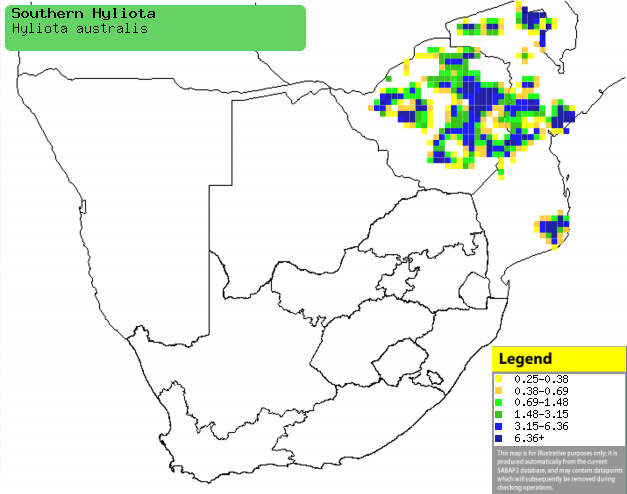|
Hyliota australis (Southern
hyliota, Mashona hyliota)
Mashonahyliota [Afrikaans]; Mashona-hyliota [Dutch];
Hyliote australe [French]; Maschona-hyliota [German]; Papa-moscas-austral
[Portuguese]
Life
> Eukaryotes >
Opisthokonta
> Metazoa (animals) >
Bilateria >
Deuterostomia > Chordata >
Craniata > Vertebrata (vertebrates) > Gnathostomata (jawed
vertebrates) > Teleostomi (teleost fish) > Osteichthyes (bony fish) > Class:
Sarcopterygii (lobe-finned
fish) > Stegocephalia (terrestrial
vertebrates) > Tetrapoda
(four-legged vertebrates) > Reptiliomorpha > Amniota >
Reptilia (reptiles) >
Romeriida > Diapsida > Archosauromorpha > Archosauria >
Dinosauria
(dinosaurs) > Saurischia > Theropoda (bipedal predatory dinosaurs) >
Coelurosauria > Maniraptora > Aves
(birds) > Order: Passeriformes
> Family: Sylviidae > Genus: Hyliota
Distribution and habitat
Although it has two isolated populations in Kenya and
Tanzania, the bulk of its population lies in patches from Angola and Zambia to
southern Africa. Here it is generally uncommon, occurring across much of
Zimbabwe extending into central and southern Mozambique. It prefers miombo (Brachystegia)
woodland, especially Mountain-acacia (Brachystegia glaucescens) woodland
on hillsides but less common in riverine Ana-tree (Faidherbia albida)woodland.
|
 |
|
Distribution of Southern hyliota in southern Africa,
based on statistical smoothing of the records from first SA Bird Atlas
Project (©
Animal Demography unit, University of
Cape Town; smoothing by Birgit Erni and Francesca Little). Colours range
from dark blue (most common) through to yellow (least common). |
Movements and migrations
In Zimbabwe it is short distance migrant, in
Winter heading to lower altitudes in the south-eastern lowveld and
Kariba Basin.
Food
It mainly eats insects, doing most of its foraging in the
woodland canopy, gleaning prey from leaves and branches. It regularly joins
mixed species foraging flocks, along with passerines such as
Green-capped eremomelas,
Brubrus and
Spotted Creepers.
Breeding
- Monogamous, strongly territorial solitary nester; nests are widely spaced
and defended by the male, who chases away any other species in his
territory.
- The nest is a small, thick-walled cup built of bark shreds, lichen and
moth egg cases, lined with grass and other soft plant fibres. It is
typically bound with spider web to a fork in the tree canopy, 4-12 m
(usually 7-8 m) above ground.
- Egg-laying season in Zimbabwe is from September-March, peaking from
September-November.
- It lays 2-4 creamy white or pinkish eggs.
Threats
Not threatened, although destruction of miombo (Brachystegia)
woodland in Zimbabwe has caused fragmentation of its distribution.
References
-
Hockey PAR, Dean WRJ and Ryan PG 2005. Roberts
- Birds of southern Africa, VIIth ed. The Trustees of the John Voelcker
Bird Book Fund, Cape Town. .
|
